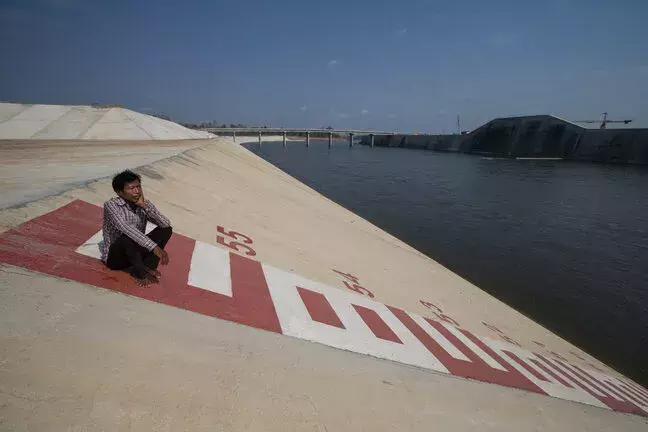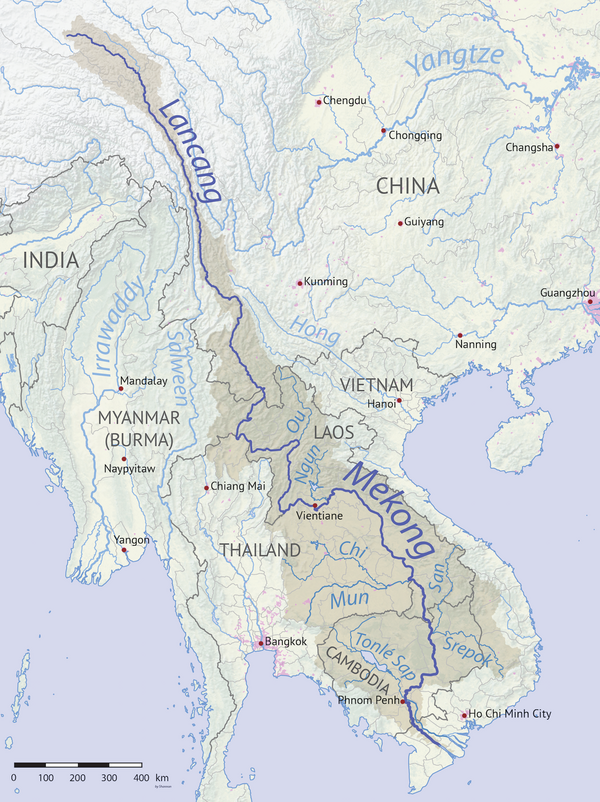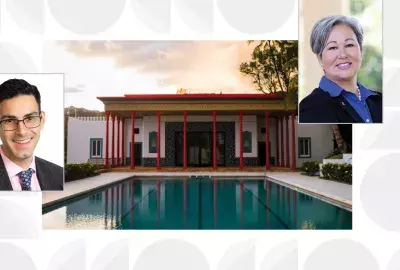Error message

Exploring the far-reaching impacts of ‘out of control’ dam construction along Southeast Asia’s lifeline
Quick take:
- Dam building along Southeast Asia’s vital Mekong River is ‘out of control,’ according to experts.
- Investment profit incentives and lack of a centralized electricity market have resulted in industry ‘water grabbing.’
- Impacts are far-reaching, from international friction to widespread ecological damage.
HONOLULU (June 3, 2021) -- As dam-building projects continue to proliferate along Southeast Asia’s vital Mekong River, experts in a recent online discussion panel agreed that the area is fast becoming overloaded with them, dredging up far-reaching issues ranging from international friction and industry “water grabs” to widespread ecological disasters and the growing impacts of climate change. Speakers at the recent East-West Center Research Program virtual panel on “Mekong Dams: Debates and the Politics of Evidence agreed that such pressing issues require urgent, collaborative problem-solving.
Serious impacts on river sustainability
The discussion centered around the socioeconomic impacts of dam construction to the tens of millions who live in the Lower Mekong Region. The April 28 webinar was the final installment in a four-part series on “The Mekong, China, and Southeast Asian Transitions” co-organized by Michigan State University’s James Madison College and Asian Studies Center, the East-West Center, the University of Hawai'i’s Center for Southeast Asian Studies and Center for Chinese Studies, and Chiang Mai University’s Regional Center for Social Science and Sustainable Development.

Apichai Sunchindah, an independent development specialist in Bangkok, delved into the enormous economic, environmental and cultural significance of the 2,700-mile-long river that is shared by China, Myanmar, Laos, Thailand, Cambodia and Vietnam. Reflecting on how dams along the river are affecting those who rely on its waters, he told panel moderator Wisa Wisesjindawat-Fink of Michigan State University that the Mekong “supports diverse ecosystems and the livelihoods of millions of people within the basin. However, development activities have caused serious impacts on the sustainability of the river and the environment.”
Uneven distribution
The Mekong serves as a major trade route and between China and Southeast Asia. Over time, China has developed a strategic hold over the waterway through its development of several large-scale hydropower dams. But as more dams continue to be built, downstream nations have been left to battle the effects of an uneven water distribution system.
Carl Middleton, an expert in international development studies at Chulalongkorn University in Bangkok, explained that the drivers of dam construction can be traced to the political economy of the electricity industry, specifically the hydropower sector. Without a centralized electricity market in place, private and state-led companies compete to manage resources.
“Each country has its own rules,” Middleton said. “There’s not really a formal electricity market in the region.” He noted that there’s been an overall shift from state-led projects to private-sector developments, creating new profit incentives for the hydropower industry to invest in dam construction.
“For many of the projects that have been built, public participation is weak, forced resettlement is poorly conducted, especially in terms of livelihood recovery, and there’s limited access to redress,” he said. “So it can be understood as a form of water grabbing.”
Pon Souvannaseng, Assistant Professor of Global Studies at Bentley University in Massachusetts, argued that past regional financial crises and recent power-sector reforms have created strong incentives for quasi-private companies to hold early shares in projects before offloading them to make large profits.
Ecological point of no return
Brian Eyler, Director of the Southeast Asia and Energy, Water, and Sustainability Programs at the Stimson Center in Washington, DC, agreed that damming in the region has become an overcrowded industry. Noting that some 20 percent of the world’s freshwater fish come out of the Mekong basin, he said that there are nearly 100 dams already built or currently under construction in Laos, scores of dams in the Central Highlands and Vietnam, and many dams already in place in China.
“We believe that too many dams are scheduled to be built in the Mekong region, and it might be the case that too many have already been built,” he said. “This is driving the mightiness of the Mekong to a point of ecological no return.”
Eyler added that the process for damming the Mekong in Laos has gotten “out of control,” leading to the proliferation of dam-building projects and the sale of assets to foreign entities. “There are a lot of dams that are being built without markets for power development,” he said.
Climate change and Mekong damming
Nguyen Huong Thuy Phan, academic coordinator at the Graduate Institute in Geneva’s Development Policies and Practices program for Southeast Asia, called for more evidence-based studies on the relationship between climate change and hydropower. “Climate change is one of the main threats for Mekong development,” she said.
Reviewing arguments for and against hydropower projects in the region, Phan said there are valid environmental assertions made by both sides: While a push toward cleaner energy sources can help lessen greenhouse gas emissions, the changing river discharges can increase climate variability, possibly inviting more disaster.
Meanwhile, Eyler noted that regional droughts exacerbated by climate change have also impacted the viability of hydropower projects. “Turbines cannot run if there’s no water there,” he said.
Data custodians
Phan encouraged more transparency and enhanced data sharing for monitoring river projects and analyzing proposed alternatives. “We can come to scenarios only if we have data, otherwise [they] have no meaning,” she said.
The reasons for current lack of data sharing are embedded in the policies and practices of the countries that are “data custodians,” she said. “When data is not freely shared among the governmental departments themselves, we cannot expect that they will be shared to independent or international researchers.”
Eyler said that private monitoring efforts like the Stimson Center’s Mekong Dam Monitor, which uses satellite and social media updates to provide real-time reporting on dam operations, have been useful for filling in gaps left by official bodies and can offer information that gives locals more time to adapt and prepare.
Top Photo: A Cambodian man sits where his home used to be, before it was bulldozed to make way for the Sesan 2 dam in the Mekong basin. Credit: Jason South / Fairfax Media / Getty Images
Exploring the far-reaching impacts of ‘out of control’ dam construction along Southeast Asia’s lifeline
Quick take:
- Dam building along Southeast Asia’s vital Mekong River is ‘out of control,’ according to experts.
- Investment profit incentives and lack of a centralized electricity market have resulted in industry ‘water grabbing.’
- Impacts are far-reaching, from international friction to widespread ecological damage.
HONOLULU (June 3, 2021) -- As dam-building projects continue to proliferate along Southeast Asia’s vital Mekong River, experts in a recent online discussion panel agreed that the area is fast becoming overloaded with them, dredging up far-reaching issues ranging from international friction and industry “water grabs” to widespread ecological disasters and the growing impacts of climate change. Speakers at the recent East-West Center Research Program virtual panel on “Mekong Dams: Debates and the Politics of Evidence agreed that such pressing issues require urgent, collaborative problem-solving.
Serious impacts on river sustainability
The discussion centered around the socioeconomic impacts of dam construction to the tens of millions who live in the Lower Mekong Region. The April 28 webinar was the final installment in a four-part series on “The Mekong, China, and Southeast Asian Transitions” co-organized by Michigan State University’s James Madison College and Asian Studies Center, the East-West Center, the University of Hawai'i’s Center for Southeast Asian Studies and Center for Chinese Studies, and Chiang Mai University’s Regional Center for Social Science and Sustainable Development.

Apichai Sunchindah, an independent development specialist in Bangkok, delved into the enormous economic, environmental and cultural significance of the 2,700-mile-long river that is shared by China, Myanmar, Laos, Thailand, Cambodia and Vietnam. Reflecting on how dams along the river are affecting those who rely on its waters, he told panel moderator Wisa Wisesjindawat-Fink of Michigan State University that the Mekong “supports diverse ecosystems and the livelihoods of millions of people within the basin. However, development activities have caused serious impacts on the sustainability of the river and the environment.”
Uneven distribution
The Mekong serves as a major trade route and between China and Southeast Asia. Over time, China has developed a strategic hold over the waterway through its development of several large-scale hydropower dams. But as more dams continue to be built, downstream nations have been left to battle the effects of an uneven water distribution system.
Carl Middleton, an expert in international development studies at Chulalongkorn University in Bangkok, explained that the drivers of dam construction can be traced to the political economy of the electricity industry, specifically the hydropower sector. Without a centralized electricity market in place, private and state-led companies compete to manage resources.
“Each country has its own rules,” Middleton said. “There’s not really a formal electricity market in the region.” He noted that there’s been an overall shift from state-led projects to private-sector developments, creating new profit incentives for the hydropower industry to invest in dam construction.
“For many of the projects that have been built, public participation is weak, forced resettlement is poorly conducted, especially in terms of livelihood recovery, and there’s limited access to redress,” he said. “So it can be understood as a form of water grabbing.”
Pon Souvannaseng, Assistant Professor of Global Studies at Bentley University in Massachusetts, argued that past regional financial crises and recent power-sector reforms have created strong incentives for quasi-private companies to hold early shares in projects before offloading them to make large profits.
Ecological point of no return
Brian Eyler, Director of the Southeast Asia and Energy, Water, and Sustainability Programs at the Stimson Center in Washington, DC, agreed that damming in the region has become an overcrowded industry. Noting that some 20 percent of the world’s freshwater fish come out of the Mekong basin, he said that there are nearly 100 dams already built or currently under construction in Laos, scores of dams in the Central Highlands and Vietnam, and many dams already in place in China.
“We believe that too many dams are scheduled to be built in the Mekong region, and it might be the case that too many have already been built,” he said. “This is driving the mightiness of the Mekong to a point of ecological no return.”
Eyler added that the process for damming the Mekong in Laos has gotten “out of control,” leading to the proliferation of dam-building projects and the sale of assets to foreign entities. “There are a lot of dams that are being built without markets for power development,” he said.
Climate change and Mekong damming
Nguyen Huong Thuy Phan, academic coordinator at the Graduate Institute in Geneva’s Development Policies and Practices program for Southeast Asia, called for more evidence-based studies on the relationship between climate change and hydropower. “Climate change is one of the main threats for Mekong development,” she said.
Reviewing arguments for and against hydropower projects in the region, Phan said there are valid environmental assertions made by both sides: While a push toward cleaner energy sources can help lessen greenhouse gas emissions, the changing river discharges can increase climate variability, possibly inviting more disaster.
Meanwhile, Eyler noted that regional droughts exacerbated by climate change have also impacted the viability of hydropower projects. “Turbines cannot run if there’s no water there,” he said.
Data custodians
Phan encouraged more transparency and enhanced data sharing for monitoring river projects and analyzing proposed alternatives. “We can come to scenarios only if we have data, otherwise [they] have no meaning,” she said.
The reasons for current lack of data sharing are embedded in the policies and practices of the countries that are “data custodians,” she said. “When data is not freely shared among the governmental departments themselves, we cannot expect that they will be shared to independent or international researchers.”
Eyler said that private monitoring efforts like the Stimson Center’s Mekong Dam Monitor, which uses satellite and social media updates to provide real-time reporting on dam operations, have been useful for filling in gaps left by official bodies and can offer information that gives locals more time to adapt and prepare.
Top Photo: A Cambodian man sits where his home used to be, before it was bulldozed to make way for the Sesan 2 dam in the Mekong basin. Credit: Jason South / Fairfax Media / Getty Images
East-West Wire
News, Commentary, and Analysis
The East-West Wire is a news, commentary, and analysis service provided by the East-West Center in Honolulu. Any part or all of the Wire content may be used by media with attribution to the East-West Center or the person quoted. To receive East-West Center Wire media releases via email, subscribe here.
For links to all East-West Center media programs, fellowships and services, see www.eastwestcenter.org/journalists.







